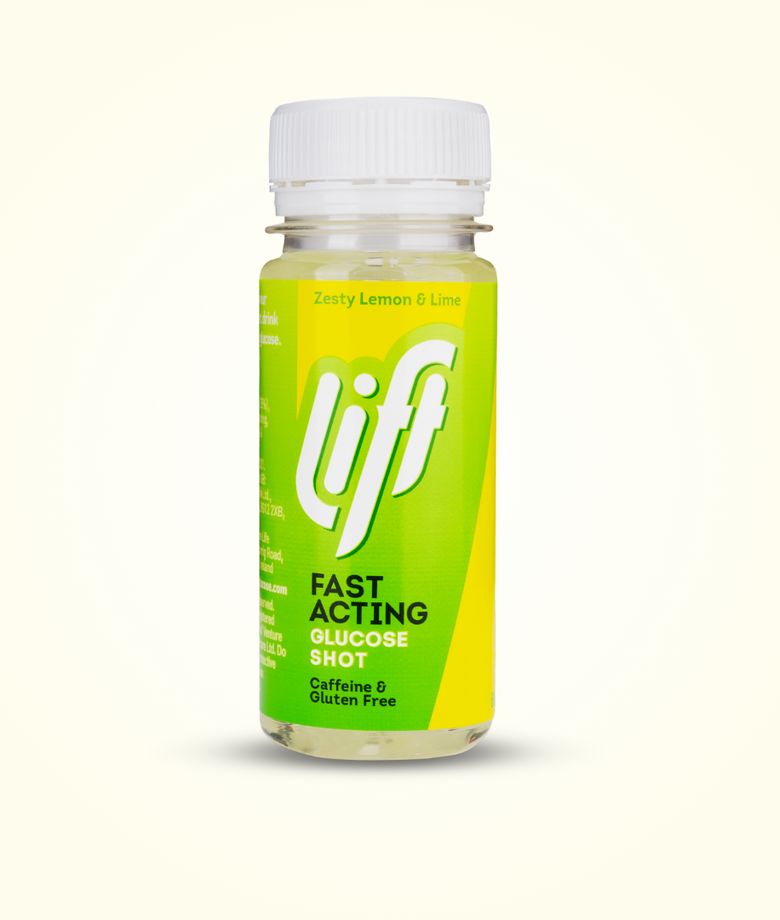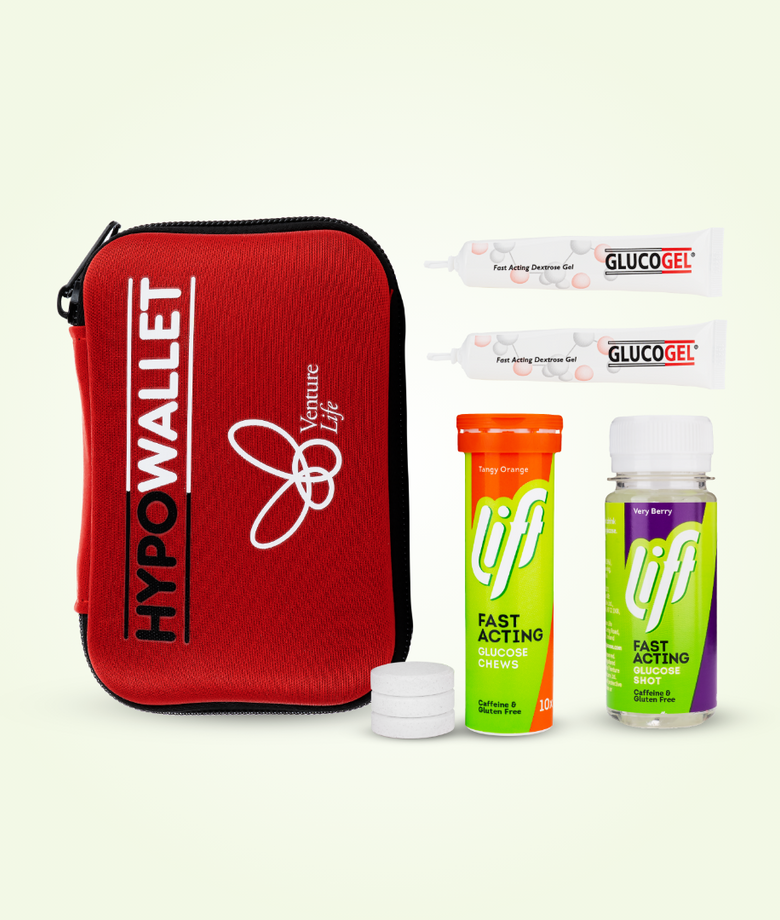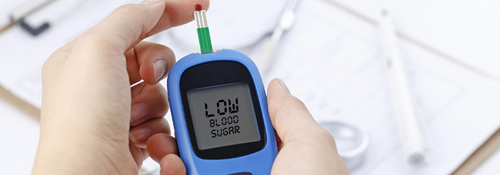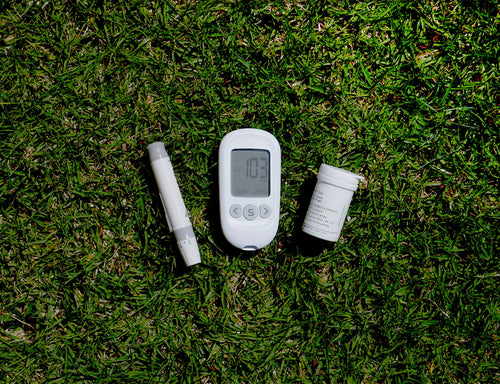Fast Acting Glucose for Hypos: Boost Blood Sugar Level
What is a Hypo?
A hypo – short for hypoglycaemia – happens when blood glucose levels drop too low. It can make you feel unwell and a bit shaken.
A hypo happens when your blood glucose level drops below 4mmol/L. If left untreated, hypos can be dangerous – but the good news is they are easy to treat.
Hypos need to be treated as quickly as possible, and the treatment is simple. If left untreated, they can cause unconsciousness and, in extreme cases they can be fatal, so having treatment in-hand all times is especially important.
Glucose tablets or shots are recommended for treating hypos because the glucose (sugar) gets into your blood stream quickly.
Common Symptoms of Hypoglycaemia
The symptoms of hypoglycaemia range from mild to moderate depending on the amount of glucose in the blood. Most people may not feel any symptoms at 4.0 mmol/L but will feel progressively worse as blood sugar levels fall.
People with diabetes may experience this degree of hypoglycaemia if they are on a form of insulin medication, although the symptoms may not be so clear. Hypoglycaemic unawareness can be especially dangerous as blood sugar levels can be critically low before a self-diagnosis is made.
Familiarise yourself with the common symptoms so you can take action quickly.
People with mild to moderate hypoglycaemia may experience adrenergic (or sympathetic) symptoms which affect their nervous system. These include:
- Blurred vision
- Insatiable hunger
- Headaches and sweating
- Pale, cold, or clammy skin
- Confusion or disorientation
- Feeling weak, sleepy, or tired
- Trouble concentrating
- Dizziness or light-headed
- Rapid or irregular heart rate
Symptoms of severe Hypoglycaemia
Symptoms of hypoglycaemia usually worsen the lower the blood glucose gets. Patients may experience severe hypoglycaemia when this level goes below 3.0 mmol/L. This is a potentially life-threatening condition. People with severe hypoglycaemia may experience the following symptoms:
- Body tremors or trembling
- Numbness of the tongue, lips, or cheek
- Mood swings or changes in personality
- Nausea, vomiting, abdominal discomfort
- Seizures or convulsions
- Loss of consciousness or coma
In some rare cases, severe hypoglycaemia may prevent people from responding to treatment by eating something to raise their blood sugar. At this point, the patient may begin experiencing neuroglycopenic symptoms as the brain fails to get enough glucose.
When this happens, glucose shots may be administered to raise their glucose levels quickly. If you start to experience any of the above symptoms, you must seek medical attention or dial 111 to reach the NHS helpline.
Watch out for early signs such as confusion or drowsiness to improve your treatment response time. If you suffer from hypoglycaemia often, you should always keep glucose tablets on your person in order to boost your sugar levels when needed.
In most cases, these symptoms will be easily recognisable and immediate treatment like a fast-acting glucose supplement will provide quick relief.
Consuming foods rich in carbohydrates can help provide relief by giving your body some much-needed fuel. However, this should be accompanied by a blood test to ensure the right blood sugar levels have been achieved.
Managing diabetes on your own terms
Although there are lots of options available to help people manage their blood sugar or hypos, glucose tablets or shots are a preferred option for many as they are a measured, fast-acting dose.
Some glucose tablets are available in tough, water-resistant, resealable on-the go packs so you can always have them with you. This is important because the symptoms of hypoglycaemia can appear quickly at odd times of the day. While a glucose shot, which come in a 15g measured dose, can be take in one shot or as required allowing you to manager your hypos on your own terms.
Treating low blood glucose: An effective way to follow the 15-minute rule
The recommended treatment for low blood sugar is to consume 15 grams of glucose every 15 minutes until your blood sugar level rises above 4mmol/L. Glucose tablets or shots make it easier to administer this treatment by providing quick-release glucose in carefully measured quantities.
You can easily treat mild to moderate hypoglycaemia by following the 15-15-minute rule. The rule states that:
Consume:
15 grams of carbohydrates such as a slice of bread, 100g yoghurt, a small banana, an apple, a glass of fruit juice or 4 glucose tablets
Wait:
15 minutes to allow the body to absorb the glucose from these foods before testing your blood glucose again to see if it rises above 4.0 mmol/L
Repeat:
If necessary or until your blood sugar level gets to 4.0 mmol/L or above
Eat:
A balanced meal as soon as possible to prevent a relapse.
Why glucose?
Fast acting glucose
People with diabetes may experience episodes of hypoglycaemia as a side effect of insulin or other types of diabetes medication. Most newly diagnosed people with diabetes will experience mild to moderate symptoms of low blood sugar as their body adjusts to treatment.
Fast-acting glucose tablets can help those with diabetes to raise their blood sugar quickly when it drops dangerously low. Due to its simple molecular formula, glucose is easily absorbed by the body and will help anyone experiencing hypoglycaemia feel better faster than most other foods.
The Glucose in these tablets are biochemically identical to the glucose produced in the human body making them instantly absorbable.
How to prevent low blood sugar
The best way to prevent hypoglycaemia is to adopt the right diabetes management practices to fit your personal circumstances. You should also learn to identify the early symptoms of hypoglycaemia so you can begin addressing them before they get worse.
Pay close attention to your blood sugar levels by testing regularly using a glucometer or a continuous glucose monitor (CGM). This will give you a good idea of the way your body functions and activities that significantly affect your blood sugar level.
Several studies have shown that people who check their blood sugar level more regularly have a lower risk of hypoglycaemia, as they are likely to recognise the signs of low blood sugar and apply treatments before it gets too low.
Prevent low blood sugar swings and symptoms with glucose tablets and supplements
For those with diabetes, it is essential to practice self-monitoring as a part of your everyday routine. This is especially crucial if you take insulin and other types of diabetes drugs to manage your blood sugar levels.
Those who frequently experience bouts of dizziness, shaking, sweating, anxiety, or irritability, can get their blood sugar back on track using glucose tablets. Glucose supplements should be consumed in conjunction with a healthy balanced diet.






